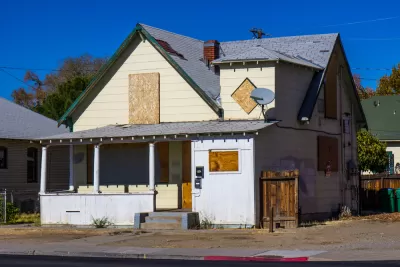Inefficiencies in Baltimore's tax sale system and predatory investment practices are keeping homes vacant for years. But advocates could soon finally see meaningful change.

Early this year, the deaths of three Baltimore firefighters (and critical injuries to another) while they battled a blaze at a vacant house in the 200 block of South Stricker Street refocused a harsh light on the decades-old problem of vacant houses in that city.
“This is a gut-wrenching tragedy for our city, the Baltimore City Fire Department, and most importantly the families of our firefighters,” said Mayor Brandon Scott in a statement. Scott ordered a citywide review of all vacant housing operations, procedures, and processes in the wake of the tragedy. However, vacant house fires have been a recurring problem in Baltimore for years. In fact, that same house on Stricker Street that collapsed and killed the three firefighters also caught fire in 2015, and three firefighters were injured then; fortunately they all survived. However, in 2014, Lt. James Bethea died of smoke inhalation after falling inside a vacant house where he was battling a fire.
Vacant Properties are Violent. And, They Beget Violence.
As of April 14, of the 85 locations where homicides were reported in 2022, 59 have taken place at or near a property with a Vacant Building Notice, a tax lien, or a demolition. This is a fact, not a coincidence. It’s the result of extractive and exploitative economic policies targeted at Black communities, creating concentrated vacancy, poverty, and trauma.
Just as vacant houses fuel more vacancy, high crime levels, and substandard housing, Baltimore’s decrepit and convoluted tax sale system constantly replenishes the city’s monstrous vacant house inventory. There are currently 14,973 houses
FULL STORY: Vacant Homes Wither Under Flawed Tax System

Study: Maui’s Plan to Convert Vacation Rentals to Long-Term Housing Could Cause Nearly $1 Billion Economic Loss
The plan would reduce visitor accommodation by 25,% resulting in 1,900 jobs lost.

North Texas Transit Leaders Tout Benefits of TOD for Growing Region
At a summit focused on transit-oriented development, policymakers discussed how North Texas’ expanded light rail system can serve as a tool for economic growth.

Why Should We Subsidize Public Transportation?
Many public transit agencies face financial stress due to rising costs, declining fare revenue, and declining subsidies. Transit advocates must provide a strong business case for increasing public transit funding.

How to Make US Trains Faster
Changes to boarding platforms and a switch to electric trains could improve U.S. passenger rail service without the added cost of high-speed rail.

Columbia’s Revitalized ‘Loop’ Is a Hub for Local Entrepreneurs
A focus on small businesses is helping a commercial corridor in Columbia, Missouri thrive.

Invasive Insect Threatens Minnesota’s Ash Forests
The Emerald Ash Borer is a rapidly spreading invasive pest threatening Minnesota’s ash trees, and homeowners are encouraged to plant diverse replacement species, avoid moving ash firewood, and monitor for signs of infestation.
Urban Design for Planners 1: Software Tools
This six-course series explores essential urban design concepts using open source software and equips planners with the tools they need to participate fully in the urban design process.
Planning for Universal Design
Learn the tools for implementing Universal Design in planning regulations.
City of Santa Clarita
Ascent Environmental
Institute for Housing and Urban Development Studies (IHS)
City of Grandview
Harvard GSD Executive Education
Toledo-Lucas County Plan Commissions
Salt Lake City
NYU Wagner Graduate School of Public Service


























